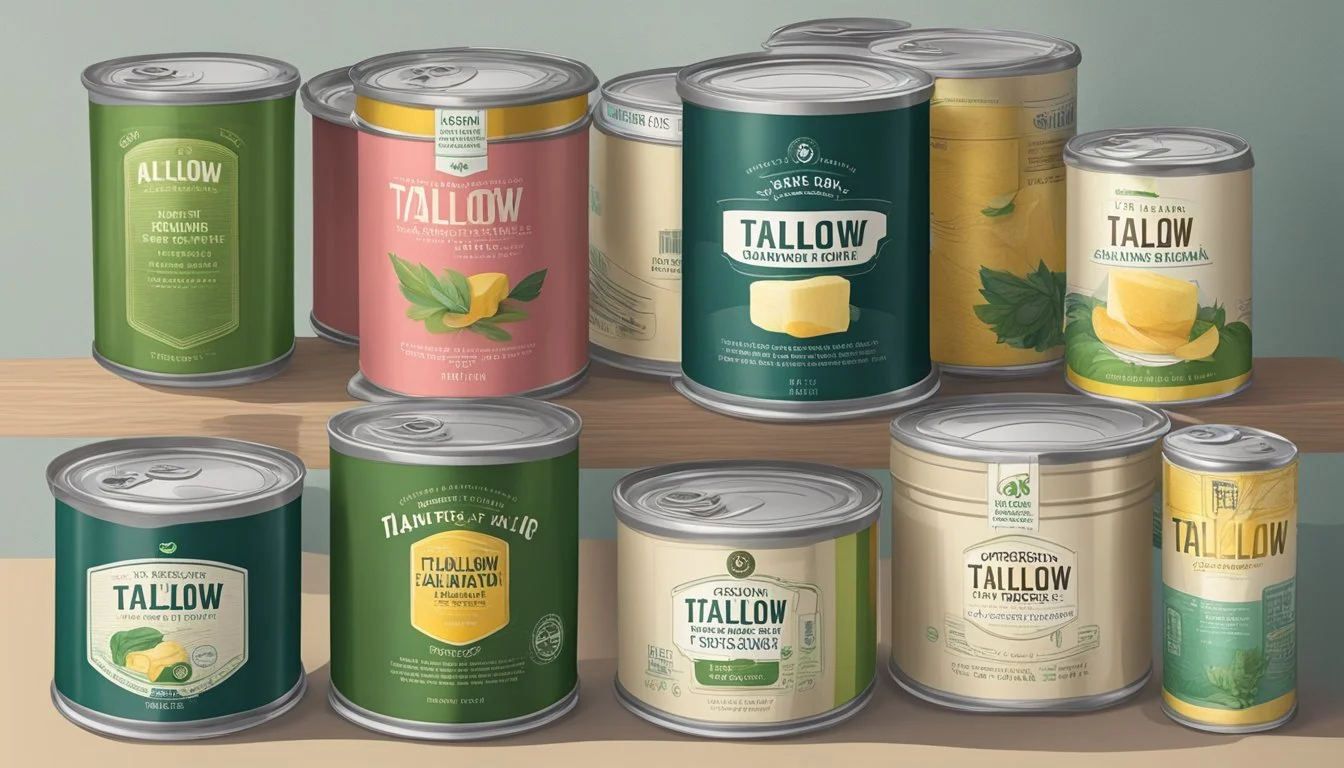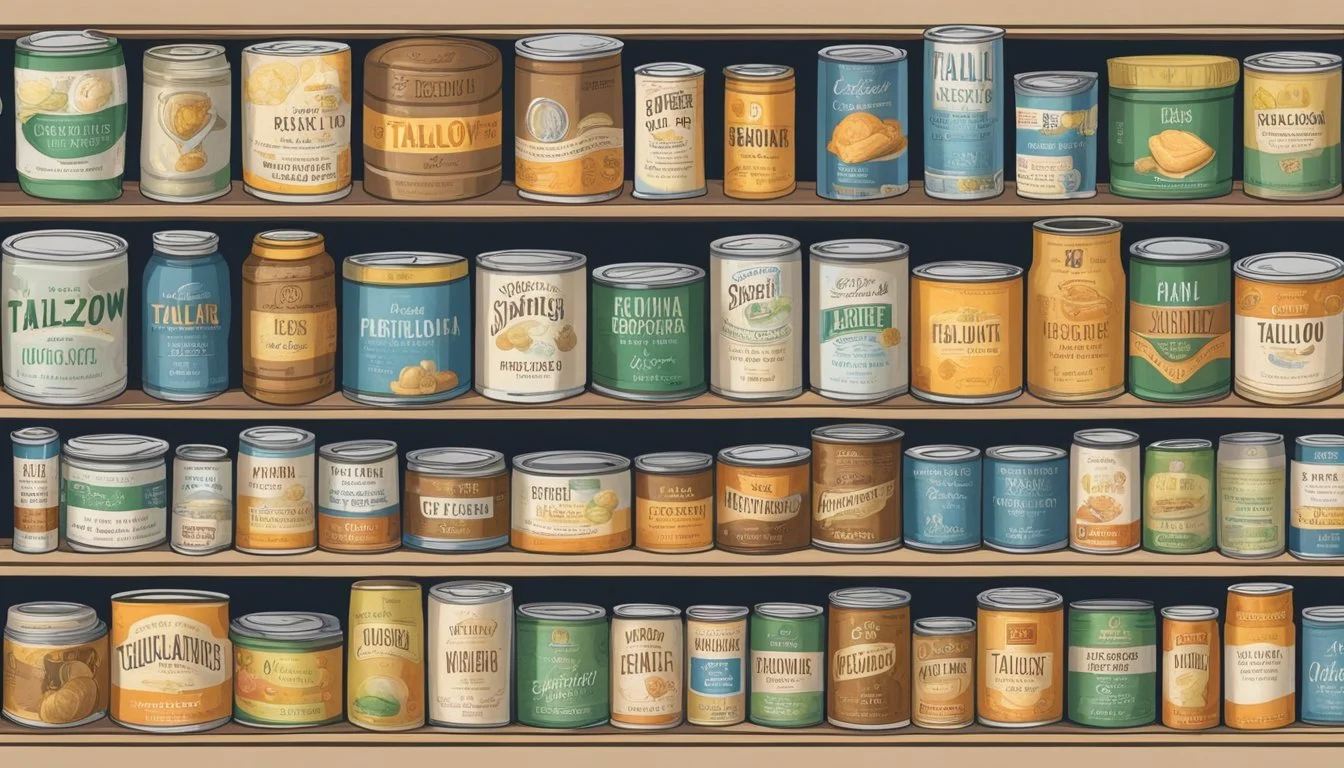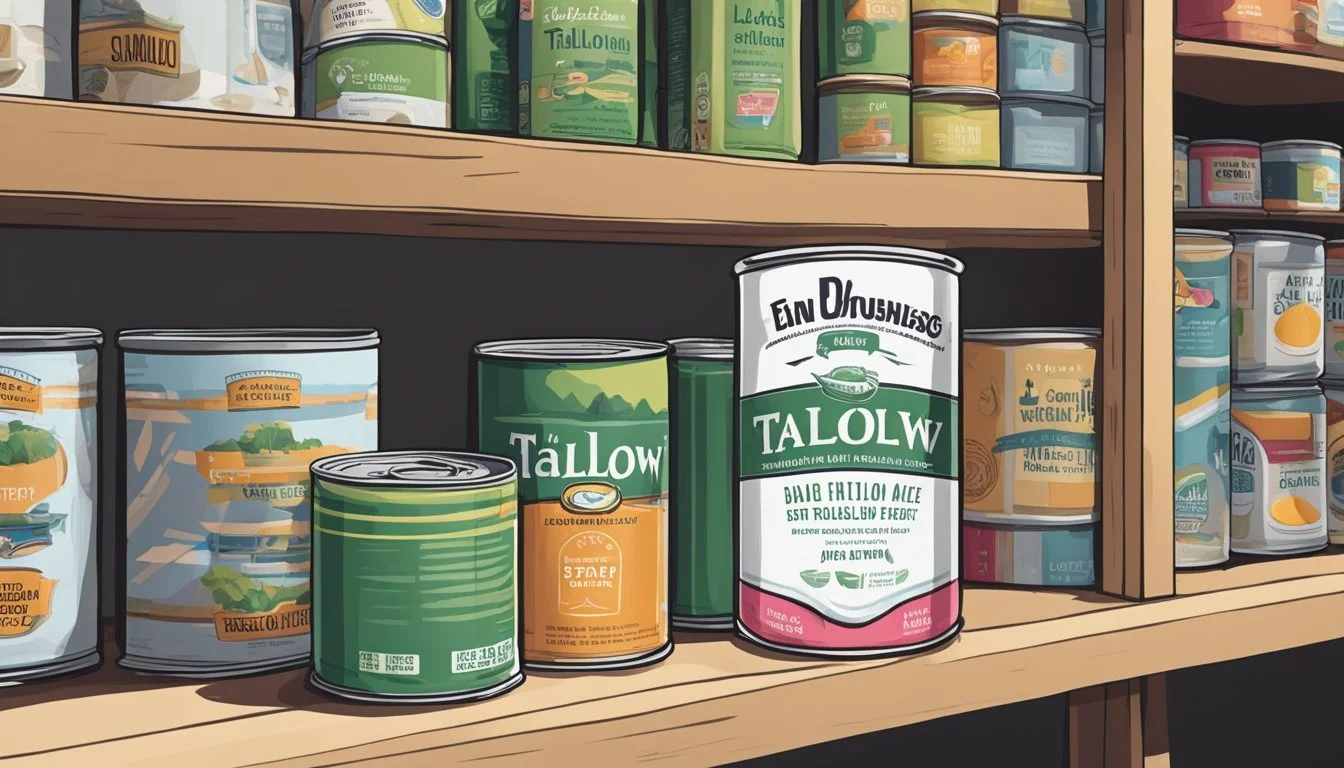How Long Does Canned Tallow Last?
Shelf Life and Storage Tips
Beef tallow, a rendered form of beef or mutton fat, has been a staple in traditional cooking for centuries due to its rich flavor and high smoke point. It is also highly regarded for its considerable shelf life, which can be extended even further through proper storage techniques. Canned tallow, in particular, appeals to those looking to stock their pantries for the long term or for those engaging in sustainable practices, where food preservation is key.
Canned tallow's shelf life is significantly influenced by the storage environment. Ideally, it should be kept in a cool, dark, and dry place to maintain its quality. When these conditions are met, canned tallow can remain stable and usable for several years. However, users must exercise caution as factors such as fluctuations in temperature, exposure to light, and the ingress of moisture can reduce its shelf life.
Understanding the importance of these factors ensures that the tallow retains its integrity, not only for culinary uses but also as a reliable source of fat in times when preservation is critical. Knowing the longevity of canned tallow and the best methods to store it equips users with the confidence that their investment in this cooking fat is well placed.
Understanding Tallow
Tallow is a traditional fat with diverse uses in cooking, and understanding its composition can inform its storage and benefits.
What Is Beef Tallow
Beef tallow is the rendered fat from beef, a by-product of the beef industry primarily used in cooking and food preparation. It's solid at room temperature and has experienced a resurgence in popularity due to its versatility and flavor. While often compared with lard, which is derived from pork, beef tallow is notable for its high heat stability, making it ideal for frying and sautéing.
Composition and Benefits
The composition of beef tallow includes a high percentage of saturated fats, along with monounsaturated fats and smaller amounts of polyunsaturated fats, including omega-3 fatty acids. Here is a breakdown of its fat composition:
Saturated fats: A solid at room temperature and stable, perfect for high-temperature cooking.
Monounsaturated fats: These fats are generally considered good for cardiovascular health.
Polyunsaturated fats, omega-3: Present in smaller quantities, they are associated with numerous health benefits.
Conjugated Linoleic Acid (CLA) is a naturally occurring fatty acid in beef tallow that's been linked to positive health effects, such as weight management and improved immunity.
In terms of health benefits, the saturated fats in tallow can contribute to immune function, cell membrane integrity, and satiation after meals. Its heat stability also reduces the risk of oxidation, making it a safer choice for cooking at high temperatures.
Rendering and Preparation
The rendering and preparation stage is crucial when making high-quality tallow that's both nourishing and potentially usable in products such as healing salves. Ensuring that the tallow is free of impurities affects its longevity and quality.
Rendering Process
Rendering is the process of melting down beef fat to separate the fat from impurities. One begins by chopping the fat into small, consistent pieces which allows for even melting. It is important to render at a low temperature, typically between 225 to 250 degrees Fahrenheit. This slow cooking method typically takes 4 to 5 hours and ensures that the tallow is rendered properly without burning.
Stirring: Regular stirring helps to ensure even rendering and prevents burning.
Time: Finely chopped tallow renders in about 4 to 5 hours; larger, less finely chopped pieces may take up to 24 hours.
Straining Impurities
After the tallow has melted, one must strain it to remove any leftover solids to enhance purity. Straining is typically done through a fine mesh strainer or cheesecloth, which filters out small impurities that might affect the tallow's quality.
Method: Pour the rendered fat through a strainer into a clean container.
Repeated Straining: For higher purity, strain the liquid tallow multiple times until no visible impurities remain.
By carefully rendering and straining the tallow, the preparation ensures a higher quality product free of impurities, which can later be canned for longevity.
Storage Guidelines
Proper storage extends the shelf life of canned tallow, with the choice of container, storage location, and maintained temperature being pivotal factors in preservation.
Optimal Storage Conditions
The key to long-term storage of canned tallow is stability. Tallow should be kept in an environment that is consistently cool and dark to prevent spoilage. Exposure to light and heat can accelerate the degradation of tallow, leading to rancidity. To maintain quality, canned tallow should ideally be stored at a room temperature of about 68°F (20°C) or cooler if not refrigerated or frozen.
Container Selection
Canned tallow thrives in airtight containers that minimize exposure to air and moisture, which can lead to spoilage. The best choices for containers are:
Glass jars with tight-fitting lids, such as mason jars
Plastic containers designed for food storage
Stainless steel containers for an inert and durable option
One should ensure the container's interior is clean, dry, and free from odors that could transfer to the tallow.
Location and Temperature
When selecting a storage location, the pantry often serves as an ideal spot due to its typically dark and cool environment. For long-term storage, one may opt for refrigeration or freezing. Here are the common storage time frames at various temperatures:
Storage Location Expected Shelf Life Pantry Up to 12 months Refrigerator 12-18 months Freezer Over 2 years
These timelines can help ensure the tallow remains fresh and usable. It's important to note that in any storage location, the tallow must maintain a stable temperature to prevent spoilage.
Shelf Life Dynamics
Understanding the shelf life of canned tallow is crucial as it determines how long the product can be stored before it starts to spoil. The longevity of beef tallow is influenced by a myriad of factors including storage conditions and treatment prior to canning.
Shelf Life Factors
Several key elements affect the shelf life of beef tallow:
Temperature: Cooler temperatures significantly reduce the risk of spoilage. Room temperature can preserve tallow for about 12 months, while refrigeration may extend its life up to 18 months.
Moisture: A dry environment is essential as moisture can lead to the proliferation of mold and bacteria.
Light Exposure: Minimal exposure to light helps to maintain the quality of tallow longer by reducing the risk of oxidation.
Air Exposure: Air can cause tallow to become rancid due to oxidation. It is imperative that tallow is kept in airtight conditions.
Shelf Life Extension
To maximize the shelf life of canned tallow, consider the following:
Vacuum Sealed Bags: Utilizing vacuum-sealed bags can extend shelf life by minimizing air exposure and oxidation.
Freezing: Tallow can be effectively stored in the freezer for over 2 years. It's advised to protect it from freezer burn and flavors from other foods.
Stabilizing Treatments: Prior to canning, beef tallow may go through stabilizing treatments to make it more resistant to spoilage.
By understanding these dynamics, one can ensure that tallow remains stable and free from going rancid for an extended period, maintaining its quality and usability.
Identifying Spoilage
When it comes to canned tallow, one must be vigilant about spoilage as it can impact both flavor and safety. Spoilage signs are often detectable through sensory evaluation, while taking preventive actions can significantly reduce the risk of rancidity.
Spoilage Signs
Smell: Fresh tallow should have a mild, almost neutral scent. If it emits a rancid smell, it's a clear indication that the tallow has spoiled.
Visual Cues: Look for any discoloration or signs of mold. Spoiled tallow may darken or exhibit a greenish hue, indicating it's no longer suitable for use.
Texture: In the freezer, tallow can develop freezer burn, noticeable by a dry and leathery appearance. Although freezer burn doesn't make tallow unsafe, it can affect texture and taste negatively.
Preventing Rancidity
Airtight Storage: Use airtight containers to protect tallow from exposure to air and moisture, which can accelerate oxidation and spoilage.
Temperature Control: Maintain optimal storage temperature ranging between 50-70°F (10-21°C). Extreme temperatures both hot and cold can lead to tallow becoming rancid more quickly.
Proper Handling: Minimize the tallow's exposure to light and heat during use to prolong its shelf life. Handle with clean utensils to prevent contamination.
Usage and Applications
Canned tallow is a versatile animal fat known for its stability and high smoke point, making it a favored choice for various culinary techniques.
Culinary Uses
Tallow excels in cooking scenarios where high heat is employed. With a smoke point of approximately 400 degrees Fahrenheit, it becomes an ideal medium for frying and roasting meats and vegetables. In baking, tallow lends a desirable flakiness to pie crusts and pastries. Its rich flavor enhances the taste of food, providing a depth unattainable with many vegetable oils. Here, its direct applications in the kitchen include:
Frying: Tallow remains stable under high heat, reducing the risk of oxidation and ensuring a crispy texture.
Roasting: It imparts a distinct flavor to meats and vegetables when used as a basting fat.
Sautéing: Its high smoke point allows for quick cooking of food without the risk of creating harmful smoke.
Baking: When substituted for butter or lard, tallow can create flaky and tender pie crusts.
Non-Culinary Uses
Beyond the kitchen, tallow finds utility in various non-culinary applications due to its consistency and shelf stability. It is often used in the making of candles, soaps, and even as a skin moisturizer. The entities that best highlight its utility in non-culinary settings include:
Candles: Provides a long-burn time and is a sustainable alternative to paraffin.
Soaps: Imparts moisturizing qualities to handcrafted soaps.
Skincare: Utilized in balms and creams for its natural moisturizing properties.
Health and Nutrition
Canned tallow, particularly from grass-fed beef, is considered a stable cooking fat rich in various nutrients. Suet, which is the raw fat from which tallow is rendered, transforms into a cooking fat with a notable vitamin profile.
In terms of vitamins, beef tallow provides an array of fat-soluble vitamins depending on the diet of the cattle:
Vitamin E: An antioxidant that helps to protect body tissue from damage.
Vitamin D: Crucial for immune function and bone health.
It also contains other nutrients such as choline, beneficial for liver and brain health.
Grass-fed beef tallow is a step above conventional tallow due to its enhanced nutrient profile. Grass-fed tallow is higher in omega-3 fatty acids, which are essential fats the body can't produce by itself. Omega-3s are known for their anti-inflammatory properties and are crucial for cardiovascular health.
Nutrient Benefit Omega-3 FAs Supports heart health and reduces inflammation Vitamin E Protects cells from oxidative stress Vitamin D Essential for bone health and immune function Choline Supports liver function and brain health
While tallow is high in saturated fat, moderation is key in a balanced diet. Saturated fats should be consumed with mindfulness to maintain health.
Grass-fed beef tallow, as a high-heat cooking fat, adds more than flavor to dishes—it contributes vitamins and may provide health benefits when used in moderation as part of a diverse diet. However, one should balance its intake with other fats to maintain a well-rounded nutritional profile.
Practical Advice
In this section, useful strategies for handling canned tallow are discussed, with particular attention on defrosting and reusing tallow, as well as understanding its versatility through substitution and comparison with other products.
Defrosting and Reusing
When tallow solidifies, it can be safely defrosted at room temperature. Users should ensure the tallow returns to a pliable consistency before attempting to reuse it. For those interested in practical applications, defrosted tallow can be repurposed for skincare as a natural moisturizer, or in the creation of homemade candles and soaps due to its slow-burning properties. In the context of emergency preparedness, preppers find tallow to be a valuable commodity owing to its versatility as a lubricant and a source of light through candle making.
Substitution and Comparison
Tallow can be substituted for oils and fats in many contexts, such as in cooking or industrial applications. It is important to note the comparative advantage of tallow, which lies in its long shelf life when properly stored. Comparatively, tallow outlasts many vegetable oils and is favored in scenarios where long-term storage is essential. For a more sustainable substitute, tallow steps in as a preferred option for skincare enthusiasts seeking a natural moisturizer, signifying its potency as an all-purpose product.
FAQs and Troubleshooting
In this section, we aim to address frequently asked questions about canned tallow's shelf life and offer practical troubleshooting tips for ensuring quality and longevity.
Common Questions
How long can canned beef tallow last?
Shelf Life: Properly canned and stored, beef tallow can last up to a year in the refrigerator and upwards of two years or more in the freezer. The key to its longevity is storing it in a cool, dark place.
Should you label canned tallow with a date?
Labeling: It's essential to label the can with the storage date to track the shelf life effectively and ensure it is used within the optimal time frame.
What should canned tallow look like?
Appearance: Quality tallow should appear white to pale yellow in color. It indicates purity and proper rendering.
What is the correct way to strain tallow?
Filtering: Prior to canning, beef tallow should be filtered to remove impurities. One should strain it through a fine mesh sieve or cheesecloth while it's still warm and in liquid form.
Troubleshooting Tips
How can you tell if tallow has gone bad?
Rancidity and Bacteria: If the tallow exhibits a strong, unpleasant odor, has an off-taste, or changes in appearance, it may have gone rancid and should not be used. The presence of rancidity can indicate bacterial growth and spoilage.
What size container should be used to store tallow?
Size and Storage: Use a container size that minimizes the amount of air contact with the tallow. Airtight containers of an appropriate size help prevent oxidation and extend shelf life.
It is imperative that individuals ensure both the scent and taste of the tallow remain indicative of its purity and freshness throughout its use, especially after long-term storage, to maintain its quality for cooking and other uses.









